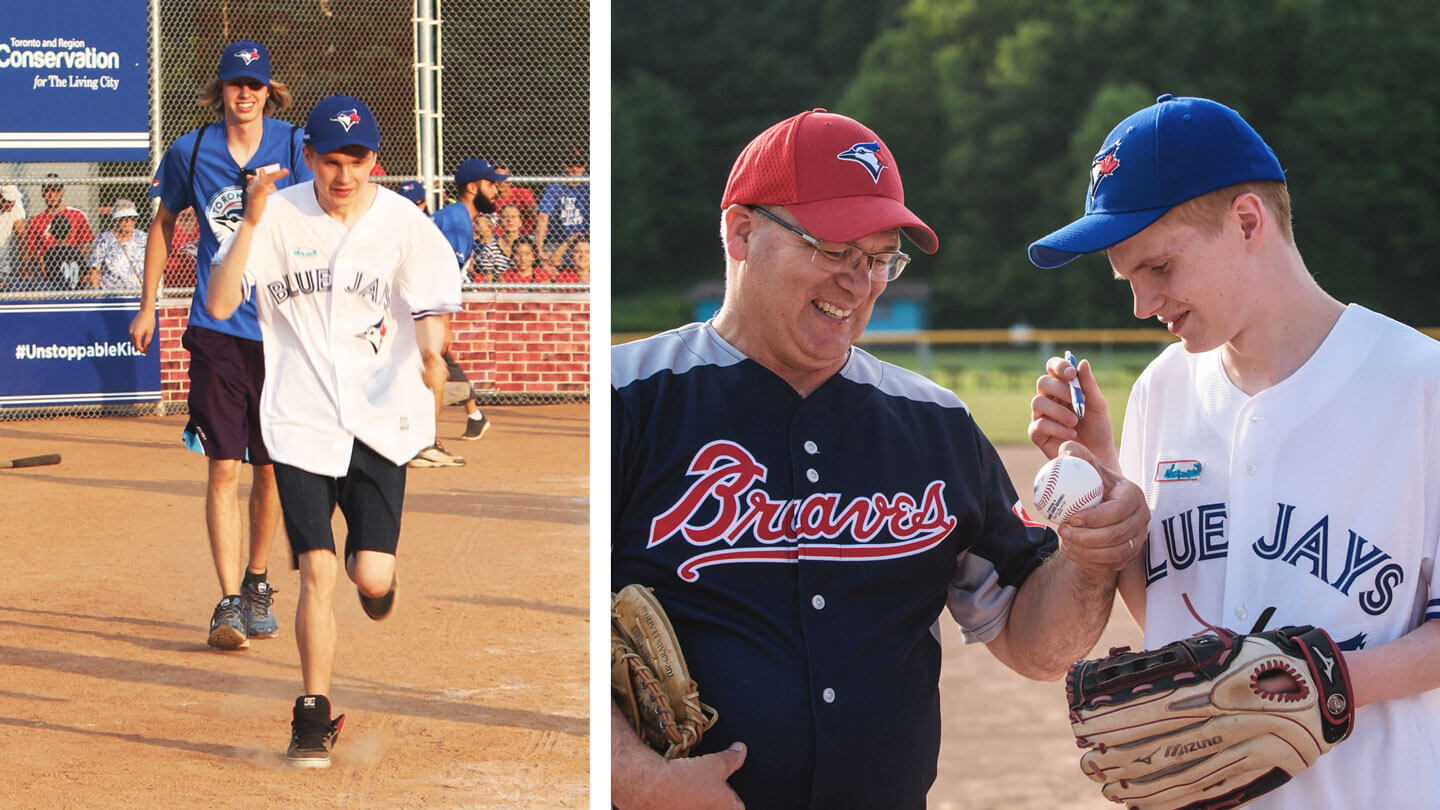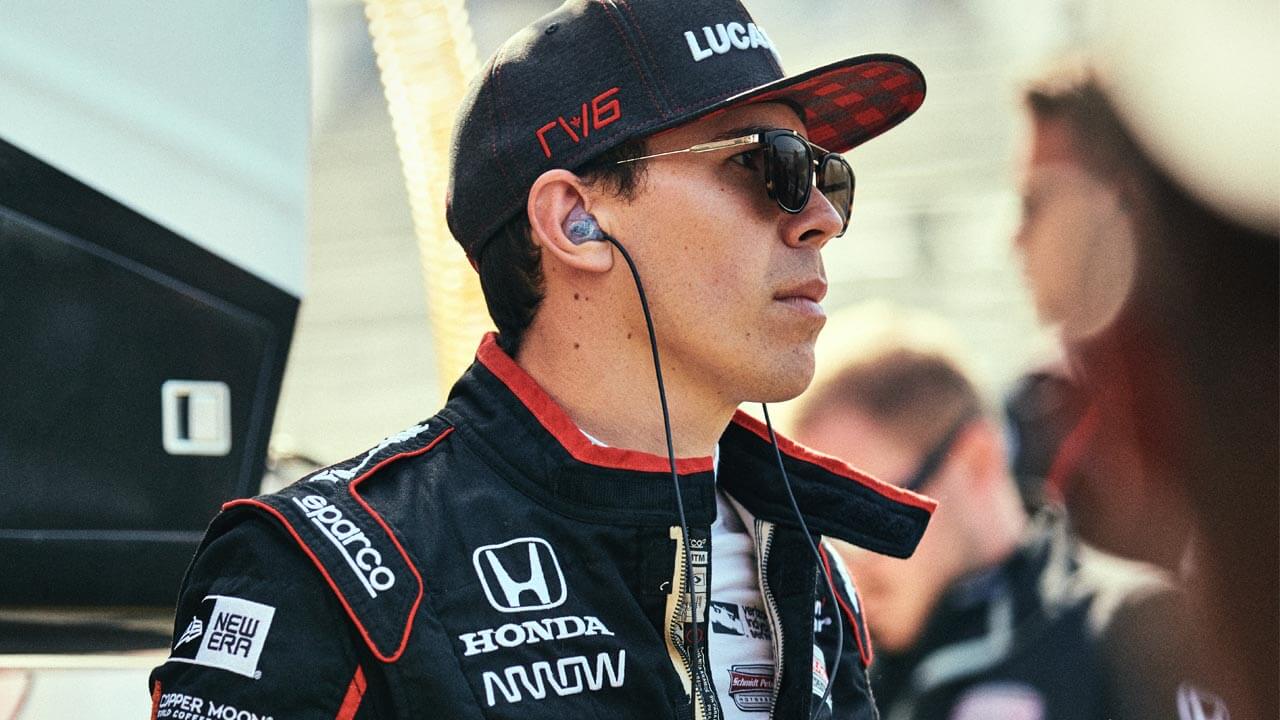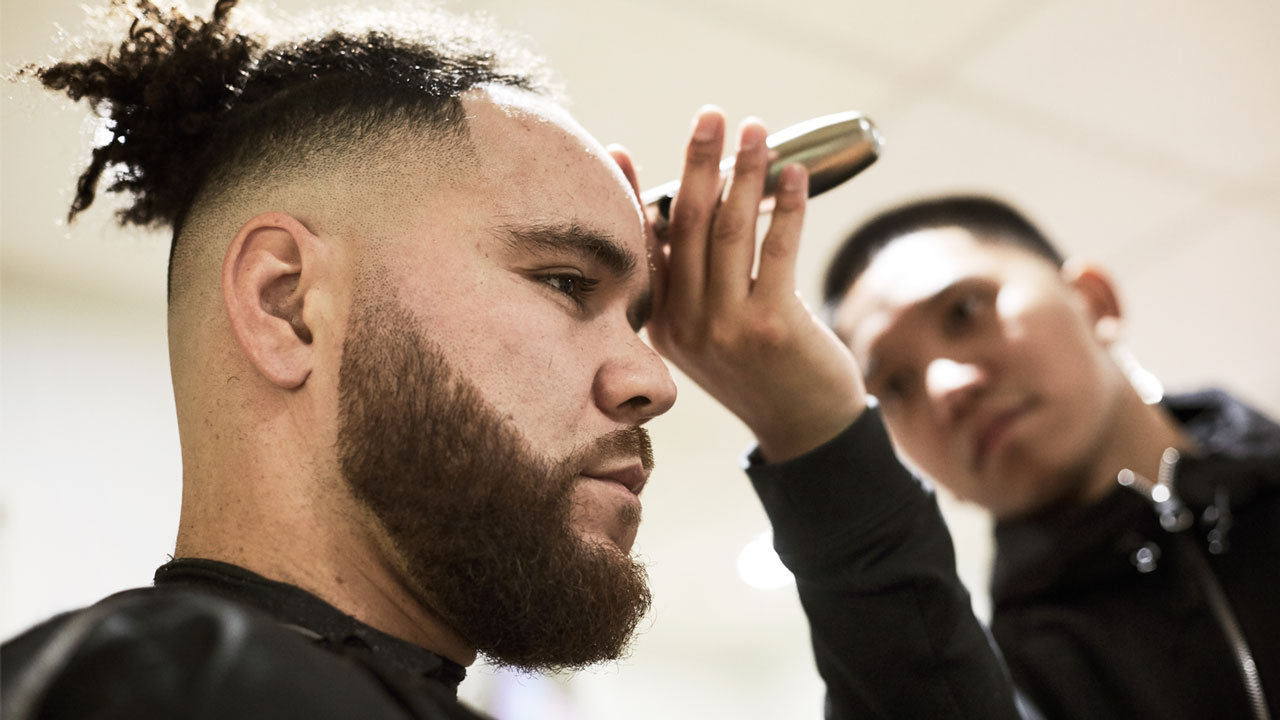As dusk set in on a hot summer day, several hundred fans filled the bleachers behind the infield fence lining a dusty red diamond. They were busy with cheers and chants. They held up Bristol board signs spelling out the names of the heroes of the day, who were introduced over a loud speaker as they took their place at bat. “Jordan Meade,” the announcer called, his voice deep, accentuating the syllables. And a confident 10-year-old, who’d warmed up playing Minecraft with laser focus on his iPhone, strutted to the plate.
Meade, whose massive smile fills out his round face, was met with wild applause from the onlookers. He’d recently become a bit of a local legend after negotiating his own trade from his minor-league baseball team to a rival he felt had a bit more speed on the base paths. In his first game after the deal, Meade helped his new team to a win.
And now, on a ball diamond surrounded by tall, green trees, Meade took a hearty swing at the tee and cracked a hard ground ball that just slipped away from the opposing shortstop. He reached first base with a furious stomp as the crowd cheered, and jumped on the bag twice more for emphasis. Then he turned to his older brother, Justin, who had run along the first-base line behind him. They connected with a big high five and Jordan’s bright smile filled his face once more.
Although he’s also a source of great older-brother annoyance, 13-year-old Justin is Jordan’s buddy — his partner in this great baseball adventure. For several years, Jordan has travelled with his family to watch the older Meade brother compete with his rep baseball team from Brampton, Ont. The family just recently returned from one of Justin’s tournaments in Virginia. But this year, for the very first time, the Meade family has also been able to spend summer nights at the diamond watching Jordan swing away.
Previously, it was very difficult for Jordan to play baseball in a league with kids his age because he has autism. But the creation of a new Challenger Baseball program in his community has allowed him to join other young athletes who had been excluded from the sport because they live with cognitive or physical disabilities. The first Challenger program in Canada started in Calgary in 1989, and it has since expanded to 93 communities across the country with more than 2,500 participants, says Randy Crouse, the program’s national coordinator. Challenger Baseball offers participants a chance to learn adaptive baseball skills and play weekly games in a safe and accessible environment. Each player has his or her own volunteer buddy, who assists them through every facet of the game — as Justin does for Jordan.

The diamond that hundreds of fans gathered at on recent night in Bolton, Ont. — a small town just north or Toronto — is one of several accessible fields that have been built specifically for Challenger Baseball across Canada. The new Bolton field, partially funded by the Jays Care Foundation, was celebrated in the game between the Brampton and Caledon Challenger programs — during which the sneaky Jordan Meade stole second base with his brother racing behind him. Fifty players, took part in the kickoff, an all-star combination of teams from both the Brampton and Caledon programs. And thanks to Jays Care, the charitable arm of the Toronto Blue Jays (which, like Sportsnet, is owned by Rogers), the game came with all the trappings of a big-league event. The players were joined by Ace, the Blue Jays’ mascot, and the team’s J-Force cheering squad, and were called up to bat by Blue Jays P.A. announcer, Tim Langton.
While Jordan and Justin Meade made their way to third base, another pair of brothers followed the action from the field, playing for the Caledon team. Eighteen-year-old Nicholas Del Zotto, wearing an official white Blue Jays jersey, and his younger brother Noah settled into position directly behind second base — playing side-by-side, just as they had when they first started in the sport.
The brothers had played on the same baseball teams for several years when they were young, but Nicholas had to stop when he reached an age where his autism made it difficult for him to play at the level of his teammates. After middle school, as many of his friends went on to attend a local high school, Nicholas was enrolled in a tailored program at Ascension of Lord Secondary School in which he’s been able to develop skillsets that will help him once he graduates in three years. Although intensely proud of all her son has accomplished, Nicholas’s mother, Christine Robinson, struggled knowing that he had missed out on so many of the small moments that his childhood friends got to experience. “Knowing that Nicholas was going to have a hard time participating in the little things that are the rites of passage — driving, relationships, friendships, jobs — it’s difficult,” Robinson says. “He’s got other gifts that are amazing, and I wouldn’t change it for anything. But it is hard when your child is not reaching his milestones and everyone else is.”
Since those early days playing minor baseball, Nicholas has remained a fan. He regularly catches the Blue Jays on television and attends games at Rogers Centre. His favourite player is Darwin Barney, who he thinks has a cool name. Nicholas also heads to the diamond to watch his younger brother Noah pitch for the Bolton Braves, a competitive rep team.
Now, Noah is able to come to the diamond to see his older brother swing for the fences and help him navigate the infield. The brothers, who work together on a regular paper route, have been able to grow even closer through their mutual love of the sport they once again share. “He hasn’t really had this opportunity before,” says Noah, a lanky 16-year-old with shaggy blond hair. “It’s a whole other experience.”
Every Saturday morning, Nicholas and Noah head to the ballpark together. Nicholas takes his favourite position, in the outfield, while Noah coaches. Eight to 10 players from each of the two teams join them, ranging in age from three years old to one player in his forties. Christine and her husband, Ryan Robinson, are both buddies on the team — along with Nicholas and Noah’s father, Enzo Del Zotto. As buddies, they each assist a member of the team as they bat, take the bases and play in the field. The games are among the family’s most anticipated events of the week. On those Saturday mornings, Christine sees the small moments unfolding — of belonging, of accomplishment, of sportsmanship — that will be invaluable to both of her sons. “It’s about being part of a team. Being committed to something,” she says. “Getting up and putting your uniform on. Playing with others.”
It’s also about having a place to play — a space where an athlete’s disability is less of a restriction on his or her ability to participate in the game. Many of the Challenger players use a wheelchair, walker, cane or leg braces to assist their mobility, but most municipal diamonds have been built without those realties in mind. Traditional dugouts, for example, usually only have enough room for about eight players. Accessible baseball requires much more room to allow for teams that double in size with the participation of buddies. And even without the extra bodies, most dugouts are far too narrow for a wheelchair to pass through — or in some cases, enter at all.

The new Challenger diamond in Bolton looks like any other field at first glance. But there are differences: Dugouts are closer to the size used by major-league teams. The bench is split into several sections, with gaps where wheelchairs can be set — so players who use them can sit alongside their teammates as they cheer on the next rally. The backstop is also set much further behind the plate than on a typical diamond, allowing a better view from the protruding dugout for players to catch the action. The infield is packed with firm red dirt, which is free from any divots or slopes, allowing players to round the bases without unnecessary obstacles.
The effort to build a field in Bolton was spearheaded by Michael Ortolan, who is heavily involved in the area’s baseball community. Now in his late forties, Ortolan grew up nearby, playing sports outdoors with a group of neighbourhood kids that he’s still close with today. Among them was a friend named Tony DeCarolis, who has Down Syndrome. Like many kids living with disabilities, DeCarolis played sports with his friends until he just wasn’t able to keep up. Years later, when the small group of friends joined a slow pitch league in their early twenties, DeCarolis was able to play with them again, as long as their opponents were willing to accommodate. Ortolan realized how much the opportunity to play meant to his dear friend. During his opening address before the first game at the field in Bolton, Ortolan choked up as he thanked DeCarolis, who’s now in his early fifties and wasn’t in good enough health to make it.
The Challenger baseball program in Bolton came to be after Ortolan saw an ad for the initiative and asked the Bolton Baseball Association to look into supporting a local chapter. After they agreed, he worked with the City of Caledon and the Toronto and Region Conservation Authority to find a space where an adaptive field could be built. They decided that an old overnight camp, tucked within a forest clearing, provided the perfect spot for what they nicknamed a “field of dreams.” While the Bolton program took off and the diamond was constructed, another Challenger program was launched in nearby Brampton, which is now in its inaugural season.
And so, on a night in early July, 50 baseball players took their turn at bat and in the field — on a diamond designed for and dedicated to them. Between innings, “Okay Blue Jays” and “Take Me Out to the Ball Game” rang out from the overhead speakers and everyone sang along. It was a familiar ballpark scene. There were hotdogs, cardboards signs, lawn chairs holding grandparents beside the bleachers. Equipment bags hung neatly in the dugout. Players leaned against the fence, chewing bubble gum. Others fiddled with their gloves and warmed up, playing catch and swinging bats. Clouds of red dust stirred in the infield and the sky turned pink over the trees beyond the outfield. And there was wild applause for the names announced as each player made their way to the plate. There were cheers for Isabella Amodio, Noah Botelho, Caitlin Creighton, Yusuf Shaikh, Brooklynn Belcher, Jax Dodge, Hannah Seaman and the dozens of their teammates who played with them as the sun fell.
Standing on third base, Jordan Meade admired the dark Blue Jays jerseys that he and his Brampton teammates wore. “We’re the Brampton Blue Jays,” he told Justin, pointing out that the opposing Caledon team wore the white version of the Toronto uniform and should therefore be known as the “Caledon White Jays.”
As they discussed the matter, a young teammate in a wheelchair took a hard swing at the plate, driving a grounder through an infielder’s legs along the third-base line.
“Go, go, run!” Justin said, as his brother turned and darted for home. Jordan touched the plate with a casual one-foot tap and kept his stride as he passed the packed bleachers, moving towards his cheering teammates in the Brampton Blue Jays dugout. And soon, together, they took to the field for their next turn playing the game they loved.





